
Vincent Clair Gair was an Australian politician. He served as Premier of Queensland from 1952 until 1957, when his stormy relations with the trade union movement saw him expelled from the Labor Party. He was elected to the Australian Senate and led the Democratic Labor Party from 1965 to 1973. In 1974 he was appointed Australian Ambassador to Ireland by the Whitlam government, which caused his expulsion from the DLP.

Dutton Park is an inner southern suburb in the City of Brisbane, Queensland, Australia. In the 2016 census, Dutton Park had a population of 2,024 people.

ANZAC Square is a heritage-listed town square and war memorial located between Ann Street and Adelaide Street, in Brisbane, Queensland, Australia. It is a state memorial to the men and women who participated in overseas armed service and is named in honour of the Australian and New Zealand Army Corps. ANZAC Square is adjacent to ANZAC Square Arcade.

Yeronga Memorial Park is a heritage-listed park at Ipswich Road, Yeronga, City of Brisbane, Queensland, Australia. The park has an area of 224,600 square metres (2,418,000 sq ft) and is one of the oldest in Brisbane, having been established in 1882, and has been a World War I memorial since 1917. It was added to the Queensland Heritage Register on 2 December 2005.

Ipswich Road is major road in the City of Brisbane, Queensland, Australia. The road has been an important transport route since the 19th century when it connected the towns of Brisbane and Ipswich. In the 1990s, the section from Moorooka in Brisbane to Riverview in Ipswich was replaced by the Ipswich Motorway.

The Sydney Cenotaph is a heritage-listed monument located in Martin Place, in Sydney, New South Wales, Australia. It was designed by Bertram Mackennal and built from 1927 to 1929 by Dorman Long & Co. It is also known as Martin Place Memorial and The Cenotaph. It is one of the oldest World War I monuments in central Sydney. It was added to the New South Wales State Heritage Register on 11 November 2009.
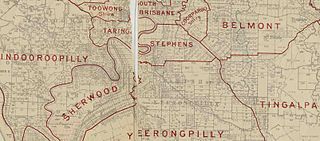
The Shire of Stephens was a local government area in the inner southern suburbs of Brisbane, Queensland, Australia. The shire, administered from Annerley, covered an area of 9 square miles (23 km2), and existed as a local government entity from 1886 until 1925, when it was amalgamated into the City of Brisbane under the City of Brisbane Act 1924.
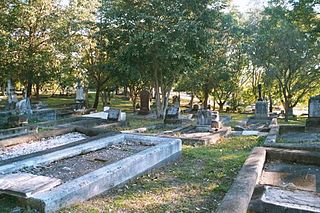
South Brisbane Cemetery, also known as Dutton Park Cemetery, is a heritage-listed cemetery at 21 Fairfield Road and Annerley Road, Dutton Park, City of Brisbane, Queensland, Australia, adjacent to the Brisbane River. It was built from 1870 to 1990s. It was added to the Queensland Heritage Register on 1 October 2003.
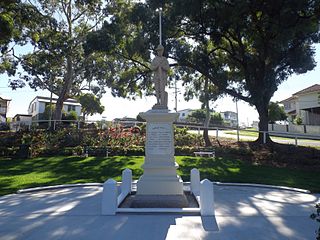
Manly War Memorial is a heritage-listed memorial at 184 Carlton Terrace, Manly, City of Brisbane, Queensland, Australia. It was built from 1920 to 1921. It is also known as Ferguson Street Reserve, Manly Dam, and Soldiers Memorial Park. It was added to the Queensland Heritage Register on 21 August 1992.

Oxley War Memorial is a heritage-listed memorial at 1218 Oxley Road, Oxley, Queensland, Australia. It was built in 1920. It is also known as Oxley Memorial Park and Oxley Place. It was added to the Queensland Heritage Register on 4 July 2006.
Annerley Road is an arterial road in Brisbane, Queensland, Australia. It was formerly known as Boggo Road due to the boggy condition of the road.
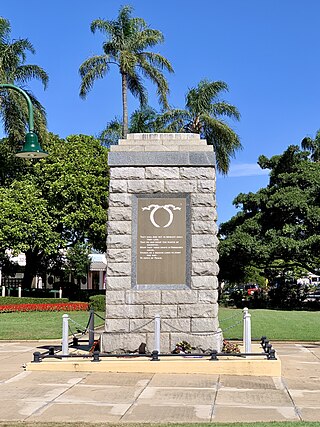
Sandgate War Memorial Park is a heritage-listed memorial at 8 Seymour Street, Sandgate, City of Brisbane, Queensland, Australia. It was designed by George Gray Prentice and built from 1923 to 1924 by Lowther & Sons. It was added to the Queensland Heritage Register on 3 October 2005.

Anning Monument is a heritage-listed memorial at the corner of Hemmant and Tingalpa Road and Boonoo Street, Hemmant, City of Brisbane, Queensland, Australia. It was designed and built by William Busby in 1903. It is also known as Hemmant Boer War Memorial. It was added to the Queensland Heritage Register on 21 October 1992.

Gympie and Widgee War Memorial Gates is a heritage-listed memorial at Mary Street, Gympie, Gympie Region, Queensland, Australia. The gates provide an entranceway on Mary Street through to the Gympie Memorial Park in Reef Street. The gates were designed by George Rae and built in 1920 by A L Petrie & Son. It was added to the Queensland Heritage Register on 21 October 1992.
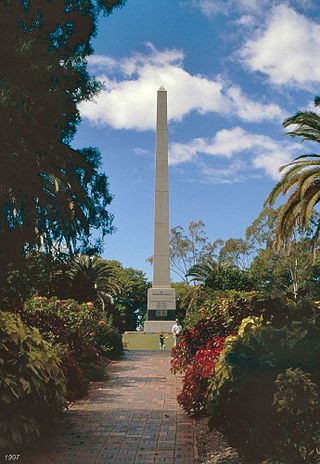
Rockhampton War Memorial is a heritage-listed memorial in the Rockhampton Botanic Gardens at Penlington Street, The Range, Rockhampton, Rockhampton Region, Queensland, Australia. It was built in 1924. It was added to the Queensland Heritage Register on 21 October 1992.

World War I Cenotaph is a heritage-listed memorial at Jubilee Park, Alfred Street, Mackay, Mackay Region, Queensland, Australia. It was designed by Stephen Harvey and built from 1928 to 1929 by Melrose & Fenwick. It is also known as Mackay War Memorial and Jubilee Park. It was added to the Queensland Heritage Register on 21 August 1992.

War Memorial and Heroes Avenue is a heritage-listed memorial at Bungil Street, Roma, Maranoa Region, Queensland, Australia. It was built in 1920. It was added to the Queensland Heritage Register on 21 October 1992.

Pialba Memorial Cenotaph is a heritage-listed memorial at Freedom Park, Main Street, Pialba, Fraser Coast Region, Queensland, Australia. It was designed by Philip Oliver Ellard Hawkes and built from 1918 to 1921 by Frederick William Webb. It was added to the Queensland Heritage Register on 6 May 2016. It is also known as the Pialba War Memorial and the Hervey Bay War Memorial.

Dutton Park State School is a heritage-listed government primary school at 112 Annerley Road, Dutton Park, City of Brisbane, Queensland, Australia. It was built from 1916 to 1934. It was also known as Woolloongabba State School, Woolloongabba Boys State School, and Dutton Park Boys State School. It was added to the Queensland Heritage Register on 30 November 2018.






















